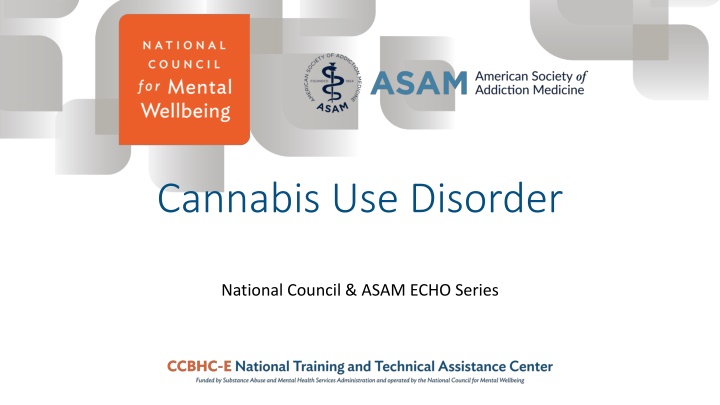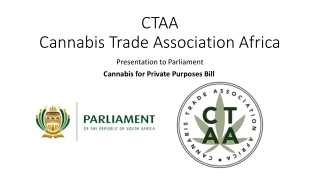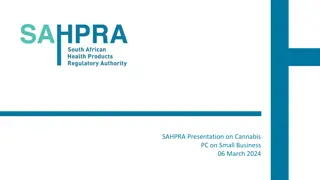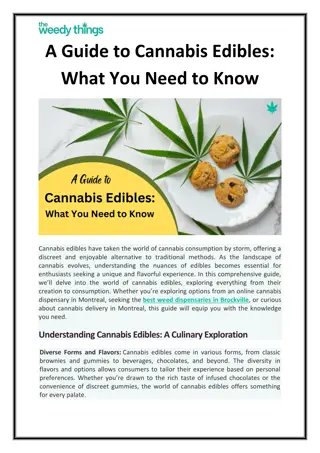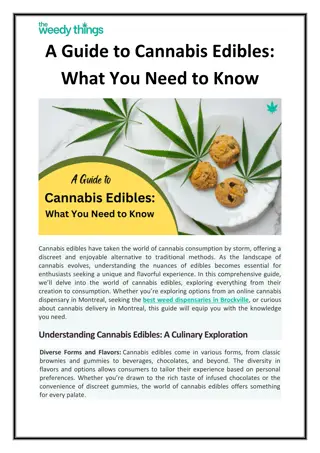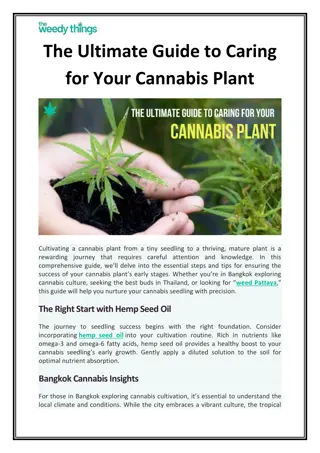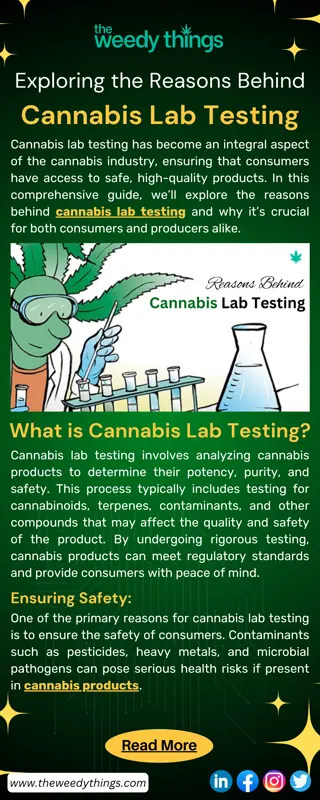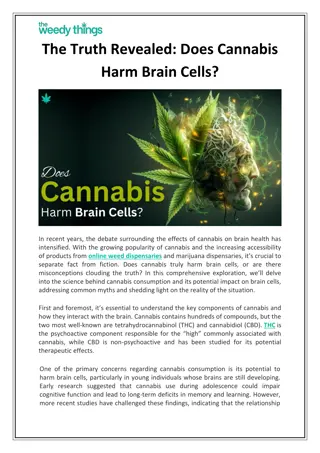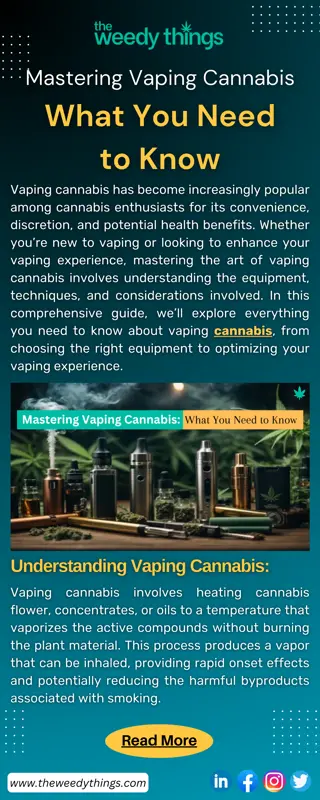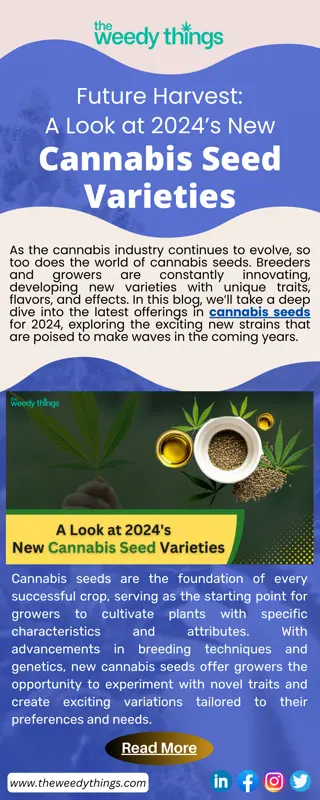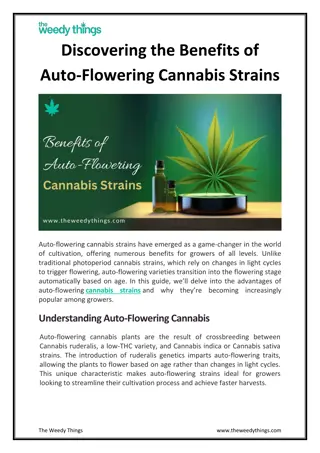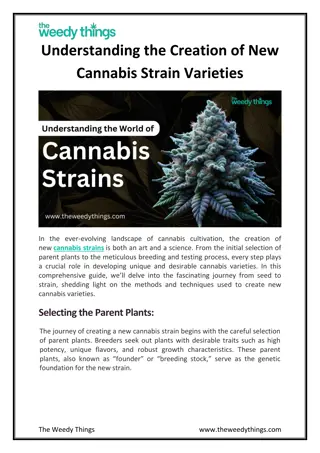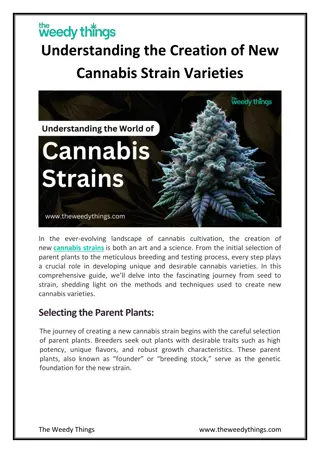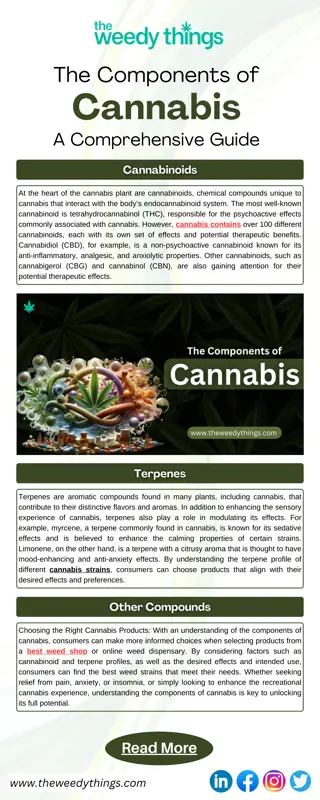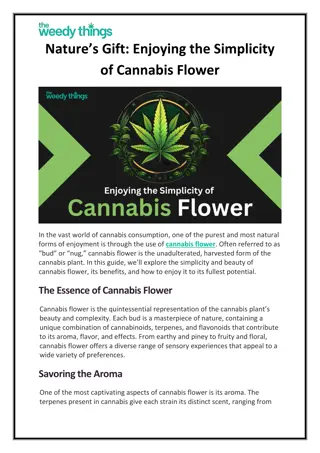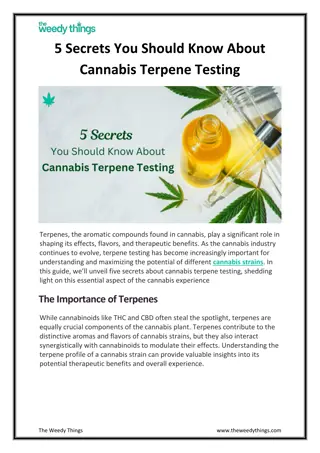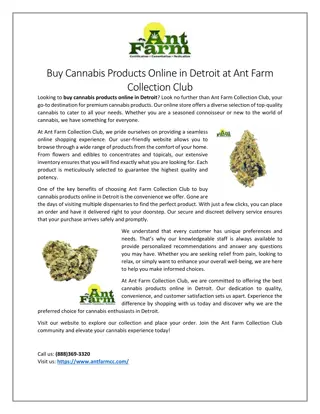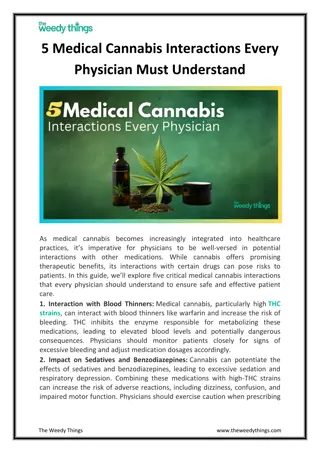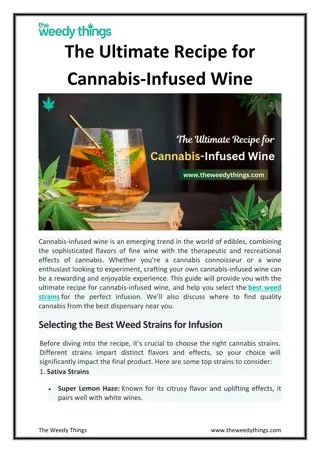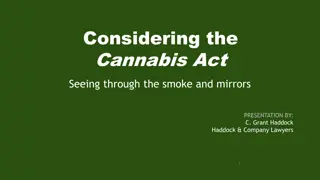Cannabis Use Disorder: National Council & ASAM ECHO Series
This publication delves into the education collaboration between American Society of Addiction Medicine and National Council for Mental Wellbeing. It highlights sessions focusing on various substance use disorders, including cannabis use disorder, with insights from professionals in the field.
Download Presentation

Please find below an Image/Link to download the presentation.
The content on the website is provided AS IS for your information and personal use only. It may not be sold, licensed, or shared on other websites without obtaining consent from the author.If you encounter any issues during the download, it is possible that the publisher has removed the file from their server.
You are allowed to download the files provided on this website for personal or commercial use, subject to the condition that they are used lawfully. All files are the property of their respective owners.
The content on the website is provided AS IS for your information and personal use only. It may not be sold, licensed, or shared on other websites without obtaining consent from the author.
E N D
Presentation Transcript
Cannabis Use Disorder National Council & ASAM ECHO Series
Introduction Poll What role/function do you operate in at your CCBHC?
This publication was made possible by Grant No. 1H79SM085856 from the Substance Abuse and Mental Health Services Administration (SAMHSA). Its contents are solely the responsibility of the authors and do not necessarily represent the official views, opinions or policies of SAMHSA, or the U.S. Department of Health and Human Services (HHS).
Education Collaboration American Society of Addiction Medicine National Council for Mental Wellbeing The National Council for Mental Wellbeing is a membership organization that drives policy and social change on behalf of more than 3,400 mental health and substance use treatment organizations and the more than 10 million children, adults and families they serve. National Council advocates for policies to ensure equitable access to high-quality services, builds organizational capacity, and promotes mental wellbeing in healthcare. ASAM, founded in 1954, is a professional medical society representing over 7,000 physicians, clinicians and associated professionals in the field of addiction medicine. ASAM is dedicated to increasing access and improving the quality of addiction treatment, educating physicians and the public, supporting research and prevention, and promoting the appropriate role of physicians in the care of patients with addiction.
CCBHC ECHO Series Session #1 Updated CCBHC Criteria Session #2 Session #3 Co-Occurring Disorders Stimulant Use Disorder 1 April 23, 2024 3:30 pm 5:00 pm ET May 28, 2024 3:30 pm 5:00 pm ET March 26, 2024 3:30 pm 5:00 pm ET Session #4 Session #5 Opioid Use Disorder Session #6 Alcohol Use Disorder Cannabis Use Disorder June 25, 2024 3:30 pm 5:00 pm ET July 23, 2024 3:30 pm 5:00 pm ET August 27, 2024 3:30 pm 5:00 pm ET
Disclaimer This publication was made possible by Grant Number 1H79SM085856 from the Substance Abuse and Mental Health Services Administration (SAMHSA). Its contents are solely the responsibility of the authors and do not necessarily represent the official views, opinions, or policies of SAMHSA, or the U.S. Department of Health and Human Services (HHS).
ECHO Series Faculty Jennifer Leggett, LPC, LADC, CPRSS CCBHC Specialist Kirk D. Moberg, MD, PhD, DFASAM Faculty Angela L. Colistra, PhD, LPC, CAADC, CCS Lead ECHO Facilitator Jordanna Windemiller, LCDC Faculty No relavant financial relationships to disclose. No relavant financial relationships to disclose. No relavant financial relationships to disclose. No relavant financial relationships to disclose.
Agenda Welcome & Introductions (15 Min) Didactic Presentation (30 Min) Didactic Presentation Q&A (10 Min) Case Presentation (30 Min) Closing Announcements (5 Min)
Recording Notice By joining this TeleECHO Session, you consent to being recorded for educational and quality improvement purposes. Your participation is appreciated. For questions or concerns, email education@asam.org.
Helpful Tips Mute microphone when you are not speaking. Position webcam effectively. Test both audio and video. Communicate clearly during clinic. Speak clearly. During discussion, use chat function only if audio is not working properly.
Please Turn On Your Camera To promote face-to-face mentorship and the sharing of knowledge, please turn on your device's camera during the ECHO session if possible.
Introductions In the interest of preserving time for presentations, please briefly state the following when called upon the session facilitator: 1. Full Name 2. Location 3. Role within a CCBHC If your mic is not functioning, please type your introductions in the Zoom chat box.
The language we choose shapes the way we treat our patients Instead of: You can say . addict, junkie, substance abuser Person with a substance use disorder Addicted baby Baby experiencing substance withdrawal Avoid Use of Stigmatizing Language Alcoholic Person with alcohol use disorder Dirty vs clean urine Positive or negative, detected or not detected Binge Heavy drinking episode Detoxification Withdrawal management, withdrawal Relapse Use, return to use, recurrence of symptoms or disorder substance abuse Use (or specify low-risk or unhealthy substance use) Substitution, replacement, Medication assisted treatment Opioid agonist treatment, medication treatment Saitz, R., Miller, S. C., Fiellin, D. A., & Rosenthal, R. N. (2020). Recommended Use of Terminology in Addiction Medicine.
Live Virtual Session: Ground Rules 1. We share cases to give time to process new information. Please participate! 2. Everyone s experiences differ: Assume the best intentions. 3. Monitor your participation: Everyone is accountable. 4. If someone says something that is not your understanding of the evidence, ask questions to clarify.
Cannabis Use Disorder National Council & ASAM ECHO Series
Learning Objectives 1. Review and discuss the diagnostic criteria for cannabis use disorder. 2. Share and analyze current evidence around high-risk and low-risk cannabis use and how to reduce harm. 3. Have case-based discussions to apply appropriate patient-centered responses and reduce provider bias.
Types of Cannabis and Routes of Administration What is Cannabis (Marijuana) Marijuana refers to the dried leaves, flowers, stems, and seeds from the Cannabis sativa or Cannabis indica plant. The plant contains the mind-altering chemical called -9 tetrahydrocannabinol (THC). Common Routes of Administration: Smoking: hand-rolled cigarettes (joints) or in pipes or water pipes (bongs). Blunts emptied cigars that have been partly or completely refilled with marijuana. Dabbing: Smoking THC rich extracts. These practices contain higher concentrated amounts of THC and are becoming more common. hash oil or honey oil a gooey liquid wax or budder a soft solid with a texture like lip balm shatter a hard, amber-colored solid Vaporizers: These devices pull the active ingredients (including THC) from the marijuana and collect their vapor in a storage unit. A person then inhales the vapor. Edibles: People can mix marijuana in food such as brownies, cookies, or candy, or brew it as a tea. Cannabis (Marijuana) DrugFacts | National Institute on Drug Abuse (NIDA) (nih.gov)
Relevant Research Brain Health: memory, learning, attention, decision making, coordination, emotions, and reaction time. Heart Health: increased risk of stroke, heart disease, and other vascular diseases. Lung Health: harms lung tissue and case scarring and damage to smal blood vessels Mental Health: linked to social anxiety, depression, schizophrenia Risk for Injury Unintentional Poisoning: edibles and food and drink infused increases the risk. Driving: slows reaction time, distorts perception, impairs coordination Cannabis Health Effects | Cannabis and Public Health | CDC
Marijuana Use in the past year, regardless of mode The percentage was highest among young adults aged 18 to 25 (38.2 percent or 13.3 million people), followed by adults aged 26 or older (20.6 percent or 45.7 million people), then by adolescents aged 12 to 17 (11.5 percent or 2.9 million people). Overall, 22.0 percent of people aged 12 or older used Marijuana in the past year (or 61.9 million people) 2022-nsduh-nnr.pdf (samhsa.gov)
Marijuana Use Disorder: Aged 12 and Older 2022-nsduh-nnr.pdf (samhsa.gov)
Past Year SUD and Mental Illness Status 2022-nsduh-nnr.pdf (samhsa.gov)
Clinician Bias Clinician bias: can be defined as attitudes and subsequent behaviors by clinicians that can influence clinical decision- making and unnecessarily limit patient choice. ___________________________________________________________ Permissive Neutral Restrictive General belief that cannabis is safe may lead to minimization of patient risk General belief that cannabis is harmful may lead to misinterpretation of patient risk
Reasons for Use Data from 20 states, gathered via the 2017-2019 Behavioral Risk Factor Surveillance System, was analyzed to examine the prevalence of past-month marijuana use reason for use, categorized as medical, recreational, or both. Why Do Americans Use Marijuana 2021.https://www.ncbi.nlm.nih.gov/pmc/articles/PMC8355057/
State Regulated Cannabis Programs State Medical Cannabis Laws (ncsl.org)
The Severity Spectrum As is the case with all DSM-5-TR diagnostic criteria, a rating scale is used to determine the severity of the substance use disorder (i.e. alcohol, cannabis, stimulants) based on the number of diagnostic criteria met. Mild: Two or three symptoms Moderate: Four or five symptoms Severe: Six or more symptoms
Cannabis use Disorder: Diagnostic Criteria Criteria Type Description Impaired Control Over Use (DSM-5-TR criteria 5 to 7) Using in larger amounts and for a longer period of time than intended Persistent desire or unsuccessful attempts to cut down or regulate use Excessive time spent obtaining, using, or recovering Experiencing craving Social impairment (DSM-5-TR criteria 5 to 7) Neglect of obligations at work, school, or home Continued use despite social or interpersonal problems Recreational, social, or occupational activities reduced https://www.ncbi.nlm.nih.gov/books/NBK565474/table/nycgsubuse.tab9/
Cannabis use Disorder: Diagnostic Criteria Criteria Type Description Risky Use (DSM-5-TR criteria 8 and 9) Recurrent substance use in physically unsafe environments. Persistent substance use despite knowledge that it may cause or exacerbate physical or psychological problems. Pharmacologic (DSM-5-TR criteria 10 and 11) Tolerance Withdrawal https://www.ncbi.nlm.nih.gov/books/NBK565474/table/nycgsubuse.tab9/
High-Risk Use Severity/Risk Correlation The more diagnostic criteria a person meets, the higher diagnostic severity rating. Higher severity = higher risk for harm & associated consequences Higher Risk Demographics Traits associated with increased odds of developing a cannabis use disorder include: Young Age Black race/ethnicity Greater intensity of use Tobacco/nicotine use Alcohol or other substance use disorder *Adolescents have been shown to be at higher risk for harm even with lower severity ratings* Cannabis (Marijuana) DrugFacts | National Institute on Drug Abuse (NIDA) (nih.gov) https://pubmed.ncbi.nlm.nih.gov/27292878/
Heavy Use Association Federal Regulations of Cannabis for Public Health in the United States USC Schaeffer
THC Potency Federal Regulations of Cannabis for Public Health in the United States USC Schaeffer
Lower-Risk Cannabis Use Guidelines The American Journal of Public Health Lower-Risk Cannabis Use Guidelines (2022) outlines the following recommendations for People Who Use Cannabis (PWUC): The initiation of cannabis use should be delayed until after late adolescence, or the completion of puberty, to reduce development-related vulnerabilities for harm PWUC should use low-potency cannabis products, i.e., cannabis products with ideally lower total THC content, or a high CBD/THC content ratio. All main available modes-of-use options come with some risk for harm; PWUC should refrain from cannabis smoking and employ alternative routes-of-use for pulmonary health protection. If use occurs by inhalation, PWUC should avoid deep inhalation , prolonged breath-holding, or similar inhalation practices. PWUC should refrain from frequent (e.g., daily or near-daily) or intensive (e.g., binging) cannabis use, and instead limit themselves to less frequent or occasional use. Where circumstances allow, PWUC should use legal and quality-controlled cannabis products and use devices. Lower-Risk Cannabis Use Guidelines (LRCUG) for reducing health harms from non-medical cannabis use: A comprehensive evidence and recommendations update - ScienceDirect
Lower-Risk Cannabis Use Guidelines The American Journal of Public Health Lower-Risk Cannabis Use Guidelines (2022) PWUC who experience impaired cognitive performance should consider temporarily suspending or substantially reducing the intensity (e.g., frequency/potency) of their cannabis use PWUC should avoid driving a motor-vehicle or operating machinery while under the influence of cannabis It is prudent for people who intend to procreate and for women who are pregnant or breastfeeding to abstain from cannabis use towards reducing possible risks for reproduction and of health harm to offspring, respectively. PWUC should exercise general caution in combining other psychoactive substances with cannabis use Some specific groups of people are at elevated risk for cannabis use-related health problems because of biological pre-dispositions or co-morbidities. They should accordingly (and possibly on medical advice as required) avoid or adjust their cannabis use. The combination of risk-factors for adverse health outcomes from cannabis use further amplifies the likelihood of experiencing severe harms and should be avoided. Lower-Risk Cannabis Use Guidelines (LRCUG) for reducing health harms from non-medical cannabis use: A comprehensive evidence and recommendations update - ScienceDirect
Summary Cannabis is legally accessible in more states than ever. Cannabis Use Disorder exists on a fluid spectrum of severity from Mild, Moderate, to Severe, and pathways to reducing harm are possible. Cannabis use in the past year was highest among young adults aged 18 to 25 When treating all SUD including CUD clinicians should all consider all mental illnesses. Heavy Use: Associated with Daily Use (defined as using on 20 or more occasions in the past 30 days) There are 12 evidence-based Lower Risk Cannabis Use Guidelines (LRCUG) and recommendations were previously developed to reduce modifiable risk factors of cannabis-related adverse health outcomes
References Batalla A, Bhattacharyya S, Y cel M, et al. Structural and functional imaging studies in chronic cannabis users: A systematic review of adolescent and adult findings. PLoS One. 2013;8(2):e55821. doi: 10.1371/journal.pone.0055821 Compton R. Marijuana-impaired driving. A report to Congress. Washington, DC: National Highway Traffics Safety Administration, 2017. https://www.nhtsa.gov/sites/nhtsa.dot.gov/files/documents/812440-marijuana-impaired-driving-report-tocongress.pdf. Accessed February 9, 2024. Cooper, M., Gyawali, S., Smith, T., & Yan, J. (2022). Key Substance Use and Mental Health Indicators in the United States: Results from the 2022 National Survey on Drug Use and Health. https://www.samhsa.gov/data/sites/default/files/reports/rpt42731/2022-nsduh-nnr.pdf DISA. MARIJUANA LEGALITY by STATE. DISA, 1 July 2023, disa.com/marijuana-legality-by-state. Fischer, B., Robinson, T., Bullen, C., Curran, V., Jutras-Aswad, D., Medina-Mora, M. E., Pacula, R. L., Rehm, J., Room, R., Brink, W. van den, & Hall, W. (2022). Lower-Risk Cannabis Use Guidelines (LRCUG) for reducing health harms from non-medical cannabis use: A comprehensive evidence and recommendations update. International Journal of Drug Policy, 99, 103381. https://doi.org/10.1016/j.drugpo.2021.103381 Franz CA, Frishman WH. Marijuana use and cardiovascular disease. Cardiol Rev. 2016;24(4):158-162. doi: 10.1097/CRD.0000000000000103. Kurtzman ET, Young-Wolff KC. Why do Americans use marijuana?. Drug Alcohol Depend. 2021;226:108880. doi:10.1016/j.drugalcdep.2021.108880. https://www.ncbi.nlm.nih.gov/pmc/articles/PMC8355057/ Lacey JH, Kelley-Baker T, Berning A, et al. Drug and alcohol crash risk: A case-control study (Report No. DOT HS 812 355). Washington, DC: National Highway Traffic Safety Administration; 2016. Leung J, Chan G, Stjepanovi D, Chung JYC, Hall W, Hammond D. Prevalence and self-reported reasons of cannabis use for medical purposes in USA and Canada. Psychopharmacology (Berl). 2022;239(5):1509-1519. doi:10.1007/s00213-021-06047-8. https://www.ncbi.nlm.nih.gov/pmc/articles/PMC9110511/ National Institute on Drug Abuse. Monitoring the Future. National Institute on Drug Abuse, 15 Dec. 2021. https://nida.nih.gov/research-topics/trends-statistics/monitoring-future National Institute on Drug Abuse.. 2019, December 24. Cannabis (Marijuana) DrugFacts. https://nida.nih.gov/publications/drugfacts/cannabis-marijuana on 2024, July 22 National Academies of Sciences, Engineering, and Medicine. The health effects of cannabis and cannabinoids: the current state of evidence and recommendations for research. Washington, DC: The National Academies Press; 2017. https://nap.nationalacademies.org/catalog/24625/the-health-effects-of-cannabis-and-cannabinoids-the-current-state. Accessed February 8, 2024. Patel J, Marwaha R. Cannabis Use Disorder. [Updated 2024 Mar 20]. In: StatPearls [Internet]. Treasure Island (FL): StatPearls Publishing; 2024 Jan-. Available from: https://www.ncbi.nlm.nih.gov/books/NBK538131/
References Patrick, M., Miech, R., Johnston, L., & O'malley, P. (n.d.). MONITORING THE FUTURE PANEL STUDY ANNUAL REPORT. https://monitoringthefuture.org/wp- content/uploads/2023/07/mtfpanel2023.pdf Richter L, Pugh BS, Ball SA. Assessing the risk of marijuana use disorder among adolescents and adults who use marijuana. Am J Drug Alcohol Abuse. 2017;43(3):247-260. doi:10.3109/00952990.2016.1164711 Richards JR, Smith NE, Moulin AK. Unintentional cannabis ingestion in children: A systematic review. J Pediatr. 2017;190:142-152. doi: 10.1016/j.jpeds.2017.07.005. Rumalla K, Reddy AY, Mittal MK. Association of recreational marijuana use with aneurysmal subarachnoid hemorrhage. J Stroke Cerebrovasc Dis. 2016;25(2):452-460. doi: 10.1016/j.jstrokecerebrovasdis.2015.10.019. Rumalla K, Reddy AY, Mittal MK. Recreational marijuana use and acute ischemic stroke: A population-based analysis of hospitalized patients in the United States. J Neurol Sci. 2016;364:191-196. doi: 10.1016/j.jns.2016.01.066. Sidney S. Cardiovascular consequences of marijuana use. J Clin Pharmacol. 2002;42(S1):64S-70S. https://doi.org/10.1002/j.1552-4604.2002.tb06005.x Subramaniam VN, Menezes AR, DeSchutter A, et al. The cardiovascular effects of marijuana: Are the potential adverse effects worth the high? Mo Med. 2019;116(2):146-153. Tashkin DP, Simmons MS, Tseng CH. Impact of changes in regular use of marijuana and/or tobacco on chronic bronchitis. COPD. 2012;9(4):367-374. doi: 10.3109/15412555.2012.671868. Volkow ND, Swanson JM, Evins AE, et al. Effects of cannabis use on human behavior, including cognition, motivation, and psychosis: A review. JAMA Psychiatry. 2016;73(3):292-297. doi: 10.1001/jamapsychiatry.2015.3278. Wang X, Derakhshandeh R, Liu J, et al. One minute of marijuana secondhand smoke exposure substantially impairs vascular endothelial function. J Am Heart Assoc. 2016;5(8):e003858. doi: 10.1161/JAHA.116.003858. Wolff V, Armspach JP, Lauer V, et al. Cannabis-related stroke: Myth or reality? Stroke. 2013;44(2):558-563. doi: 10.1161/STROKEAHA.112.671347. Wolff V, Zinchenko I, Quenardelle V, et al. Characteristics and prognosis of ischemic stroke in young cannabis users compared with non-cannabis users. J Am Coll Cardiol. 2015;66(18):2052- 2053. doi: 10.1016/j.jacc.2015.08.867.
Complete Evaluation Please follow the steps below to claim credits: 1. Go to www.asam.org 2. On the top right part of the screen, click on Login. Seach for the course Cannabis Use Disorder August 28, 2024, 3:30 PM 5:00 PM ET 3. Click Complete Post Test to answer multiple choice questions. 4. Click Complete Evaluation to provide valuable activity feedback. 5. Click the button Claim Medical Credits in the box titled Claim Credits & Certificate. Choose the type of credit and click submit. Click the button View/Print Certificate to save or print your certificate. You can view/print your certificate at any time by visiting the ASAM e-Learning Center, clicking Dashboard, and clicking Transcript/Achievements.
